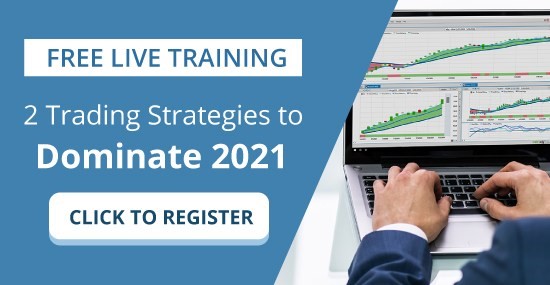
I was listening to a podcast recently and one of the hosts boasted they recently purchased call options on bitcoin with a $250,000 strike price. Whenever someone purchases a call option, they have the right (but not the obligation) to purchase the underlying asset at the agreed upon price, in exchange for a premium which they pay today. This transaction creates a limited risk on the part of the option buyer and still provides them with unlimited reward potential should the market move in their direction.
As I listened to the host talk about his purchase of a call option that was $202,000 away from the current price, I started doing all the simple arithmetic in my head.
What did he pay for the option?
When is the expiration date?
What is his break-even price?
How much of a percentage move does bitcoin need to make between now and expiration for this person to make money, assuming they are planning on holding it till expiration?
As my mind raced with all the calculations, I concluded the host was ignorant of options trading and deserved to lose everything he put up on this trade.
Sounds heartless I know.
But as the comedian Will Rogers once observed:
“There are three kinds of men. The ones that learn by reading. The few who learn by observation. The rest of them have to pee on the electric fence for themselves.”
Options trading is something that all traders should spend time studying. It can take a little while to master the basics. But once you have the basics in place you can create risk/reward scenarios using options contracts that can put the odds of success overwhelmingly in your favor.
Most importantly, you must learn the basics. It’s as simple as addition and subtraction, and by doing so you will quickly come to appreciate that limited risk is not necessarily all that it is cracked up to be.
Consider this…
I want you to think of an insurance company. It is writing policies every day insuring health, casualty, and property. In exchange for the insurance, they receive premium payments. All options contracts work off the same identical principles.
Whenever you buy an option, you have limited risk. The most you can lose is the premium that you paid. This sounds very enticing to anyone who is risk averse. But equally important in the transaction is the question, what is the probability that I will recover my premium payment on this transaction?
Let’s look at the basics of purchasing a call option graphically.
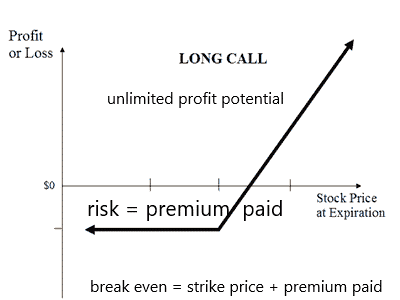
To continue with the purchasing a bitcoin $250,000 call option let’s plug some numbers in so that the chart above comes to life.
The most a buyer of an option can lose is the premium they paid for the option. So, let’s say they bought the December Bitcoin $250,000 call option and they only paid $100 for it.
That would mean that their worst-case scenario is that they could lose $100. This would occur at any price under $250,000 at expiration in December. If they were planning to hold the position through expiration their position would only be profitable at the strike price plus the amount of premium they paid. In this instance it would be $250,000 strike price plus the $100 premium. So, at any price over $250,100 they would begin to be profitable assuming that they would hold it till expiration. That means that bitcoin would have to move 420% in a period of three months for them to be profitable.
Could that occur?
While possible, it is highly unlikely.
As a matter of fact, if you look at an options price chain on whichever exchange the bitcoin options are trading, there is a Greek variable referred to as “delta” which tells you the probability of this occurring. Delta is a ratio (sometimes referred to as a hedge ratio) that compares the change in the price of an underlying asset with the change in the price of a derivative or option. The delta for this option is less than .01 which means that for every $1 that bitcoin moves this option will move less than 1 penny. Stated another way, this trade will fail on at least 99 times out of 100 attempts.
The way that I look at it that is less than optimal.
Sure, you have limited risk. But the probability of losing is extremely high. It is almost like buying a lottery ticket. In my eyes what good is limited risk if your probability of success is close to zero?
But let’s make one adjustment to this position and you can still swing for the fences, have a higher probability of success but if the trade does not work you won’t lose money. And if you structure it correctly, you can even earn a profit, even if you are 100% completely wrong.
Before we look at the adjustments, think of the analogy of options trading to the insurance business. Think about the creator or seller of the option that you purchased. That seller agreed to deliver bitcoin to you at $250,000 in exchange they took your $300 premium payment today. Let’s look at how they manage the risk on their end of the transaction.
First off, they might currently own bitcoin at lower prices and view this obligation as a low-risk way to collect additional income in their account. For example, let’s say that they own bitcoin at $30,000. When they agree to deliver and equal amount of bitcoin at $250,000, how do you define their risk? In my eyes the only risk they would have in this scenario would be the opportunity cost of the market rallying far higher than $250,000 before the expiration date. They would lose any additional profit over above the strike price of $250,000. But since they own it at $30,000, they would still have a $220,000 built in profit should that occur.
Hopefully that opens your eyes to the concept of risk management. Participants in the market create profit and loss scenarios using options strategies based not only upon their outlook, but also as a means of generating additional returns on the positions that they currently hold.
The bitcoin call option buyer, who buys the $250,00 strike price call option, can make one simple adjustment to their trade, and decide to take some risk of loss but dramatically increase their probability of success.
How?
The question to ask, is how can they finance the trade? This question when understood and explored can create a similarly bullish scenario, take some risk, and not lose money. In options trading whenever you finance a trade you are bringing income into your account to help pay for the option which you want to purchase. Since the call option you want to purchase cost $100 an options trader could potentially sell an out of the money put option and collect $300. By selling a put option they would be obligating themselves
to buy bitcoin at lower prices. In exchange for that obligation, they would receive a premium from the put option buyer.
So, while this is theoretical, it is potentially very realistic. Let’s suppose that Bitcoin which is currently trading at $48,000 has a December 20,000 put option selling for $300. Should an options trader decide to SELL that put they are collecting the $300 premium into their account right now. The amount of premium they collect is the maximum amount of money they can make on the trade. By creating that option, they are obligating themselves to BUY bitcoin at a strike price of $20,000 between now and expiration. The purchaser of that option has the right but not the obligation to sell bitcoin at a price of $20,000. That will only become more valuable should bitcoin dramatically drop in price.
This is what it looks like graphically.
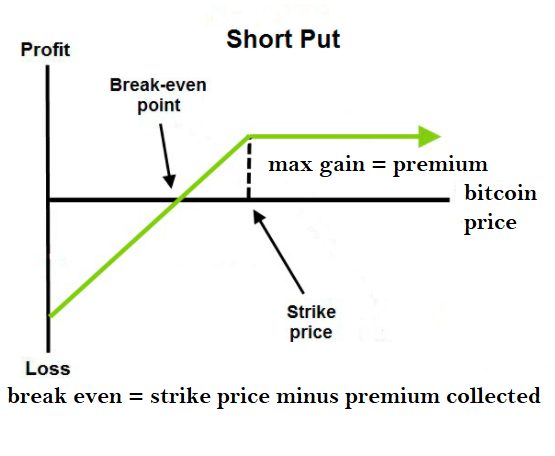
The Maximum profit that the seller of the put option can make is the $300 in premium they collected. The break even on the trade is the strike price of $20,000 minus the $300 premium collected. So, at any price over $19,700 this trade would be profitable at expiration.
But let’s look at the worst-case scenario. The worst-case scenario is that bitcoin goes to a price of zero and you obligated yourself to buy it at $20,000. If you subtract the $300 premium the absolute worst-case scenario is a loss of $19,700.
Is this a good trade? Only you can answer that question by deciding what is the probability that bitcoin would lose more than $28,000 in the next three months?
This is counterintuitive, but it is wildly profound.
When you combine the selling of a put, with the purchasing of a call option you are creating a synthetic long position using different strike prices.
What makes this theoretical scenario so unusual is that since you collected $300 by selling the put and paid $100 for buying the deep out of the money $250,000 call this trade now has a risk reward profile which means you will make $200 on the trade as long as bitcoin stays between the strike prices of $20,000 and $250,000. At any price over $250,000 your position will have unlimited upside potential. At any price of $20,000 or lower it will be just like you owning bitcoin at a price of $20,000.
This scenario is possible because you are using the bearishness of a bitcoin bear to finance your bitcoin bullishness. Since you collect $300 in premium and paid $100 in premium this is the kind of trade that all options will expire worthless the majority of the time.
Why is this important? Because instead of losing the premium on just buying the $250,000 bitcoin call option when the position expires worthless you can rollover this strategy over and over again and actually earns a small profit for your efforts.
You will learn to love everything about options trading when you are wrong about everything and still make money.
The sign of a great trader is not how much you make when you are right, but rather how little you lose when you are wrong.
This is what this adjustment and trade would look like graphically:
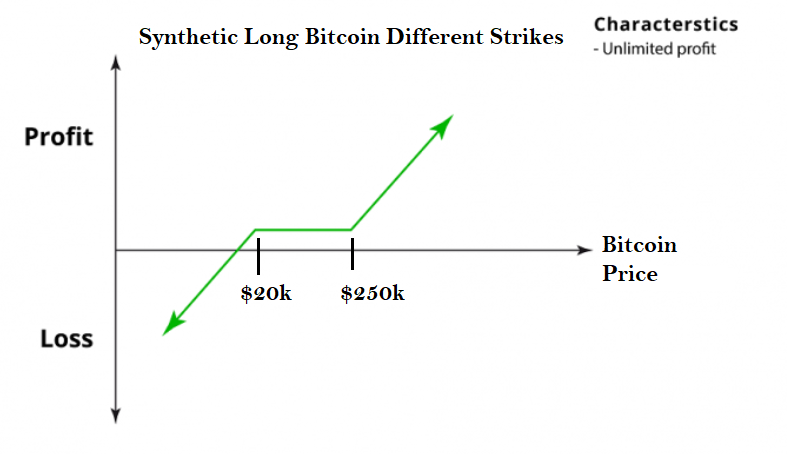
A synthetic long bitcoin strategy consists of a combination of options that results in a risk and reward profile that is like holding on to the underlying bitcoin. The position is by no means riskless but as you can see from the chart above that it will earn a small profit based upon a very broad price range in the underlying bitcoin price. The broad-based idea on this trade is that you “love” the price of bitcoin at its current price level and you will “love it more” should it drop to $20,000 or lower. If this is not your attitude or perspective this trade idea is not for you.
This options tactic is created by writing an out of the money put and a purchasing and out of the money call where both put and call have different exercise or strike prices. Hence, the term “split strikes”. If you finance the trade by collecting more premium than you pay, you can essentially swing for the fences, be wrong and still earn a profit as long as the price at expiration is above the strike price of $20,000 of the put that you sold.
The simplest way to understand it is by looking at it on a spreadsheet where you calculate the profit and loss of each side of the transaction at multiple price levels.
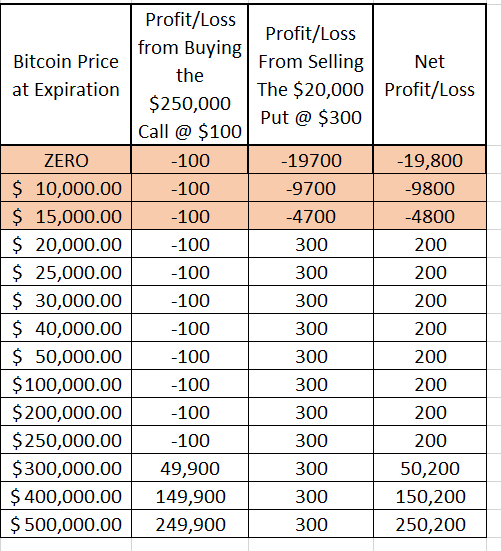
Options allow you the opportunity of creating risk reward profiles that permit you to put the odds of success overwhelmingly in your favor.
I invite you to explore the possibilities by paper trading and experimenting with all the numerous ways you can finance the trade.
I hope you never look at options the same way again and begin to explore the other sides and possibilities of the options trading transactions. Unlimited Profit Potential is very seductive, but it will destroy your trading account. Your primary mission should always be what is my probability of success.
My hope is you find risk management to be equally enticing. I invite you to explore how artificial intelligence can also dramatically change your trading results. Opinions are a dime a dozen. But artificial intelligence is so powerful because it learns what doesn’t work, remembers it, and then focuses on other paths to find a solution and best move forward. This is the Feedback Loop that is responsible for building the fortunes of every successful trader I know.
Artificial Intelligence applies mistake prevention as a continual process 24 hours a day, 365 days a year towards whatever problem it is looking to solve.
That should get you excited because it is a game-changer.
The beauty of neural networks, artificial intelligence, and machine learning is that it is fundamentally focused on pattern recognition to determine the best move forward.
A.I., through advanced pattern recognition, analyzing hundreds of thousands of data points, and crunching millions of computations, finds the highest probability trades and is indispensable in separating fact from fiction.
Artificial intelligence has decimated humans at Poker, Jeopardy, Go! and Chess. Why should trading be any different?
Knowledge.
Useful knowledge.
And its application is what A.I. delivers.
It’s important that you find out more. Join us for a FREE, Live Training. We’ll show you at least three stocks that have been identified by the A.I. that are poised for big movement… and remember, movement of any kind is an opportunity for profits!
Discover why artificial intelligence is the solution professional traders go-to for less risk, more rewards, and guaranteed peace of mind.
Visit with us and check out the A.I. at our Next Live Training.
Discover why Vantagepoint’s artificial intelligence is the solution professional traders go-to for less risk, more rewards, and guaranteed peace of mind.
It’s not magic. It’s machine learning.
Make it count.
IMPORTANT NOTICE!
THERE IS SUBSTANTIAL RISK OF LOSS ASSOCIATED WITH TRADING. ONLY RISK CAPITAL SHOULD BE USED TO TRADE. TRADING STOCKS, FUTURES, OPTIONS, FOREX, AND ETFs IS NOT SUITABLE FOR EVERYONE.
DISCLAIMER: STOCKS, FUTURES, OPTIONS, ETFs AND CURRENCY TRADING ALL HAVE LARGE POTENTIAL REWARDS, BUT THEY ALSO HAVE LARGE POTENTIAL RISK. YOU MUST BE AWARE OF THE RISKS AND BE WILLING TO ACCEPT THEM IN ORDER TO INVEST IN THESE MARKETS. DON’T TRADE WITH MONEY YOU CAN’T AFFORD TO LOSE. THIS ARTICLE AND WEBSITE IS NEITHER A SOLICITATION NOR AN OFFER TO BUY/SELL FUTURES, OPTIONS, STOCKS, OR CURRENCIES. NO REPRESENTATION IS BEING MADE THAT ANY ACCOUNT WILL OR IS LIKELY TO ACHIEVE PROFITS OR LOSSES SIMILAR TO THOSE DISCUSSED ON THIS ARTICLE OR WEBSITE. THE PAST PERFORMANCE OF ANY TRADING SYSTEM OR METHODOLOGY IS NOT NECESSARILY INDICATIVE OF FUTURE RESULTS. CFTC RULE 4.41 – HYPOTHETICAL OR SIMULATED PERFORMANCE RESULTS HAVE CERTAIN LIMITATIONS. UNLIKE AN ACTUAL PERFORMANCE RECORD, SIMULATED RESULTS DO NOT REPRESENT ACTUAL TRADING. ALSO, SINCE THE TRADES HAVE NOT BEEN EXECUTED, THE RESULTS MAY HAVE UNDER-OR-OVER COMPENSATED FOR THE IMPACT, IF ANY, OF CERTAIN MARKET FACTORS, SUCH AS LACK OF LIQUIDITY. SIMULATED TRADING PROGRAMS IN GENERAL ARE ALSO SUBJECT TO THE FACT THAT THEY ARE DESIGNED WITH THE BENEFIT OF HINDSIGHT. NO REPRESENTATION IS BEING MADE THAT ANY ACCOUNT WILL OR IS LIKELY TO ACHIEVE PROFIT OR LOSSES SIMILAR TO THOSE SHOWN.


